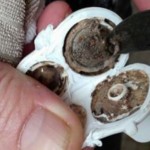17 Signs Of Mold Illness (And How To Tell If You’re At Risk)
Many people deal with the problem of mold in their home, and its presence may be the cause of a number of health issues as well.
Thus, everyone needs to be acquainted with its symptoms, no matter if you belong to the people who are most susceptible to it, so that you will be able to treat the problem and avoid adverse effects.
Still, the conventional medicine does not recognize mold as a problem, and, as a result, it does not offer any adequate treatment. Moreover, it has symptoms that resemble the symptoms of other diseases, as they are nonspecific, and are thus frequently attributed to other health problems.
Yet, these are the most common signs of the mold illness:
– Memory problems, executive function problems, brain fog, problems with concentration
– Vertigo
– Headaches
– Static ‘shocks’
– Tremors
– Fatigue, weakness, and post-exercise malaise
– Weight gain despite sufficient effort (resistance to weight loss)
– Light sensitivity, red eyes, blurred vision
– Sinusitis, cough, air hunger, asthma-like signs, shortness of breath
– Excessive thirst
– Metallic taste
– Muscle cramps, pain in the joints, constant nerve pain, aches not caused by inflammatory arthritis, ‘ice pick’ pain
– Increased urination
– Numbness and tingling sensation
– Persistent nerve pain
– Night sweats or temperature regulation issues
– Pain in the abdominal area, changes in appetite, nausea, diarrhea
As you see, the above mentioned symptoms are really often confused with the common symptoms of other diseases.
Nevertheless, mold does have disastrous effects, and they have been scientifically studied for over three decades, and it has been revealed that it is in fact a combination of a number of types of fungi that grow in filaments and reproduce by creating small spores that sprout and fly away, and cannot be spotted by the naked eye.
Mold thrives best in wet, dump, and warm places. Thus, it is an often case for it to appear in regions like Nevada and Arizona, in places with poor ventilation, or places susceptible to floods or water leakages.
As we see, mold frequently appears in the bathroom, on the showerhead, in room with poor ventilation, and it can also attach to books, to furniture, shoes, carpets, papers, even pets. It can be present and circulating in the air system, which means that it is recommended for you to change your HVAC filters every three months.
Buildings damaged by water are very prone to formation of a complex combination of contaminants present in the air and dust, which form a toxic chemical mixture. During this process, toxic substances known as mycotoxins are created, and these substances remain on spores and fragments of mold released into the air.
Nevertheless, you should know that the mold illness is not caused by a single toxin. Usually, it appears in water-damaged regions or buildings.
In addition, the latest review has revealed that sinuses may be a common reason for a persistent mold illness.
Unluckily, it is a fact that about 50 percent of the buildings we live in are water-damaged, and thus mold and mold illness are pretty frequent, especially in people who are more susceptible to it. Taking in consideration that the majority of us spend plenty of time indoors, whether it is in the office, or at home, we should all learn how to reduce this harmful influence.
Mold toxicity is classified in the wide category of biotoxin illnesses and is also known as Chronic Inflammatory Response Syndrome (CIRS).
According to Ritchie Shoemaker, an MD, and the author of eight books on the topic of mold and mold illness, including Surviving Mold: Life in the Era of Dangerous Buildings, the CIRS is an acute and chronic systematic inflammatory response acquired after an exposure to the inner environment of a water-damaged building with resident toxigenic organisms, some of them being fungi, actinomycetes, bacteria, and mycobacterium, as well as inflammagens.
Dr. Shoemaker also adds that 24 percent of people cannot make proper antibody responses. These are the people who actually comprise more than 95 percent of people who suffer from an illness caused by water-damaged buildings.
Therefore, in the following text we are going to explain the role of DNA and its effect on the proneness to mold illness.
Dr. Shoemaker has also confirmed that about 24 percent of the people are genetically prone to mold toxicity, because they have an immune response gene (HLA-DR).
Hence, these people have a raised risk of mold illness. 95 percent of the cases of mold illness include people from this subgroup.
Moreover, 2 percent of people are particularly susceptible to this illness and have a ‘sicker quicker’ variation of these genes. Even more, in case that you are not prone to the mold illness, it still does not have to mean that your chances of developing it are equal to zero.
People who are susceptible to mold illness are not able to identify specific toxins as toxins, including mold, so they get re-circulated in the body. As a result, the toxins contribute to a continuing inflammatory response.
People should know that mold illness that is the result of water-damaged building is a serious health problem, since it is a state of chronic inflammation that results from a weakened immune system, and it does not heal on its own. If you do not treat it, it can provoke different other illnesses. This illness is built into the DNA and once it gets activated, the symptoms and the inflammatory response may last for a quite long period of time.
An individual can be diagnosed with CIRS if they meet the following criteria:
– If they have a genetic predisposition to biotoxin-related illness, on the basis of a recognition of an HLA liable haplotype.
– If they have some symptoms and signs, or history of biotoxin exposure. This history should include exposure to molds that create toxins as documented by the EPA-approved ERMI examination. Moreover, in the case of microcystin, ciguatera, and so forth, the history will include probable exposure or laboratory proof of exposure.
– Abnormalities recognized by Visual Contrast Sensitivity (VCS) examinations
– Biomarkers consistent with the neuroimmune, the vascular, and the endocrine abnormalities to CIRS. If someone has consistent biotoxin exposure, an abnormal VCS test results, or is a prone genotype, they will most likely indicate the laboratory abnormalities seen in CIRS.
So, if you believe that you are exposed to mold and have some symptoms of the mold illness, here is what you should do:
– Examine if there is mold presence in your home. It is recommended that you hire an environmental expert to inspect your home or your office, or do an ERMI test. This test costs $325 and it can be done by yourself, and in case that the results show that there is mold in your home or office, you should hire the expert to get rid of the problem.
– Learn and do some studying on the topic of mold illness.
– You can also get in contact with a clinician trained in the Shoemaker Protocol and with their help, test your proneness to mold illness.
Don’t Forget To Share With Your Friends And Family On Facebook, As You Might Help Someone In Need!
Source: justnaturallyhealthy.com
Leave a Reply
You must be logged in to post a comment.


